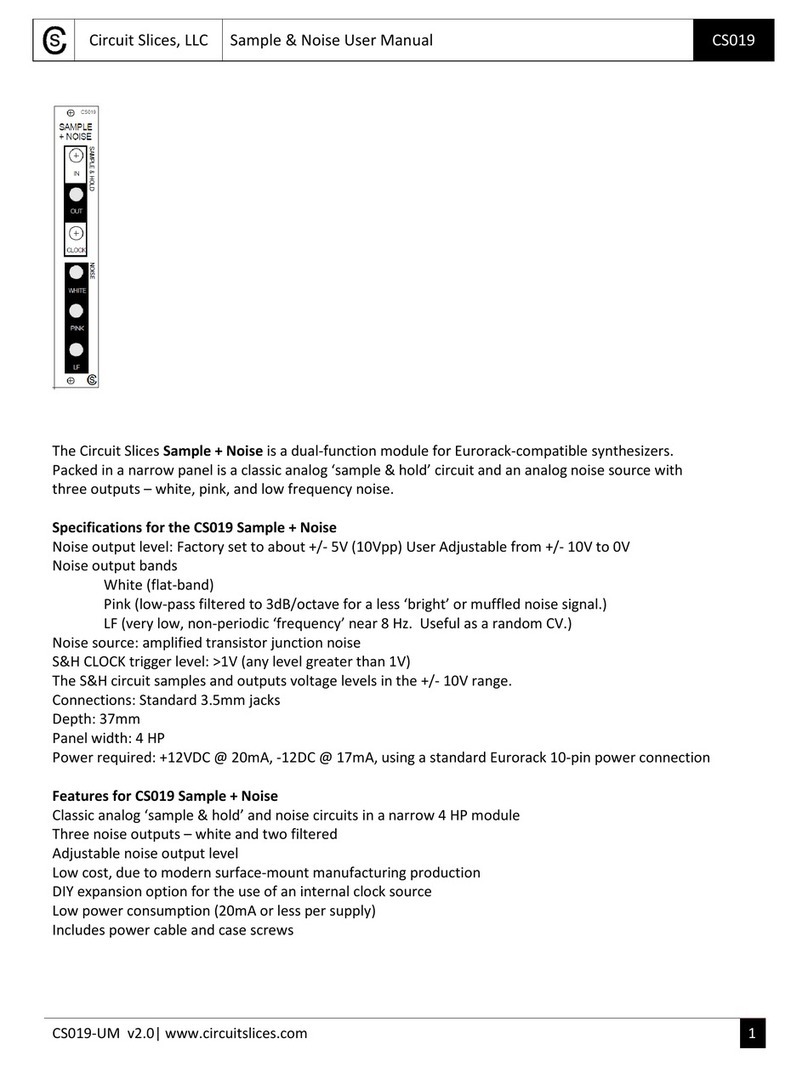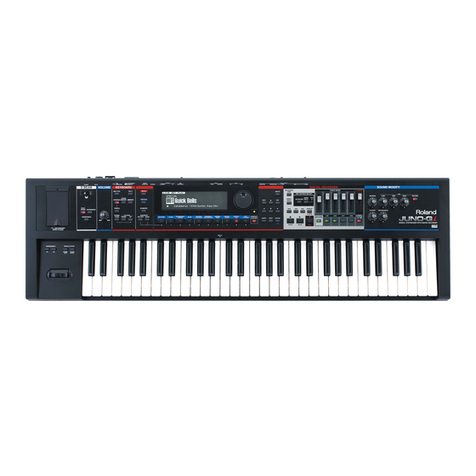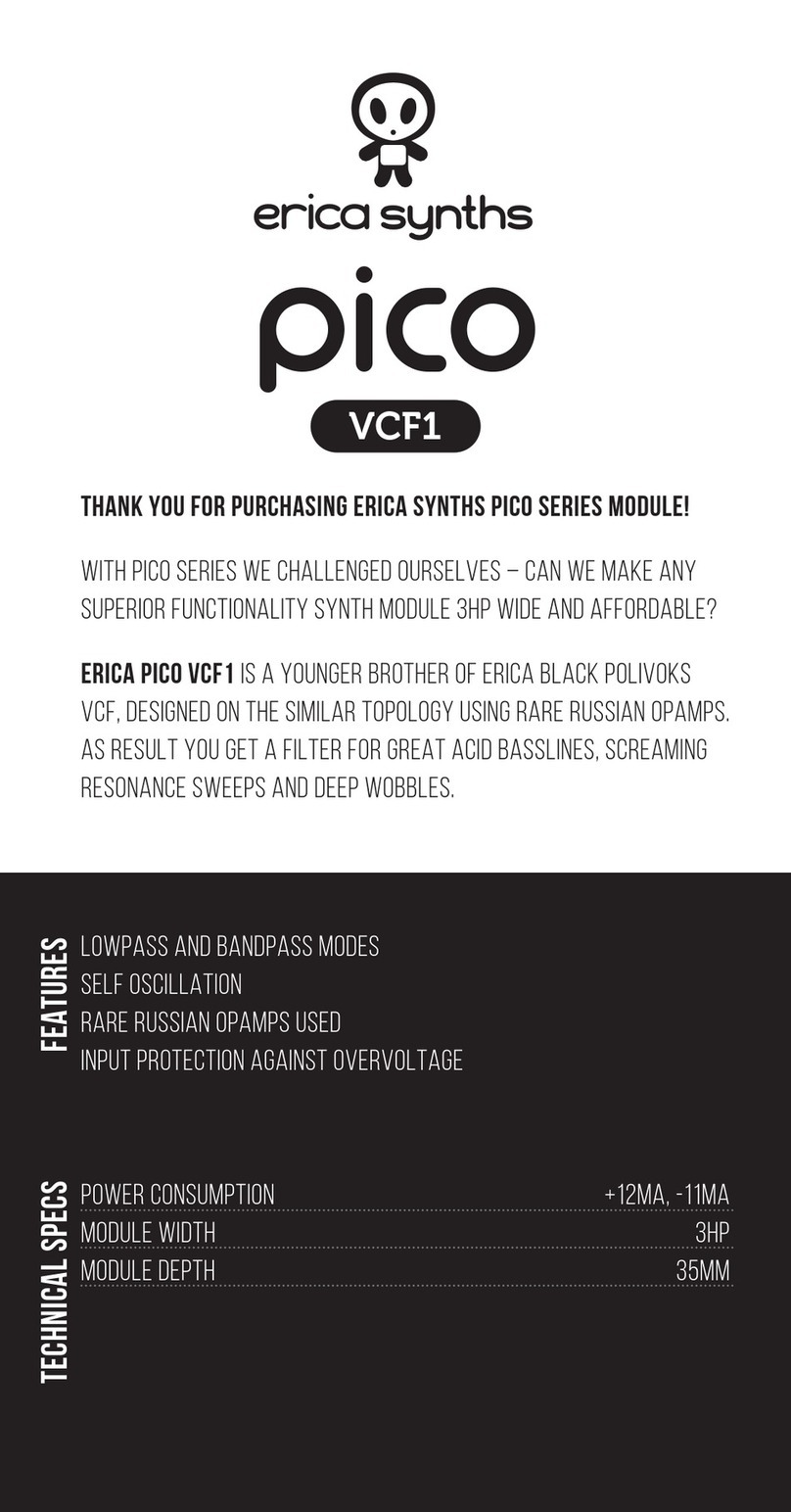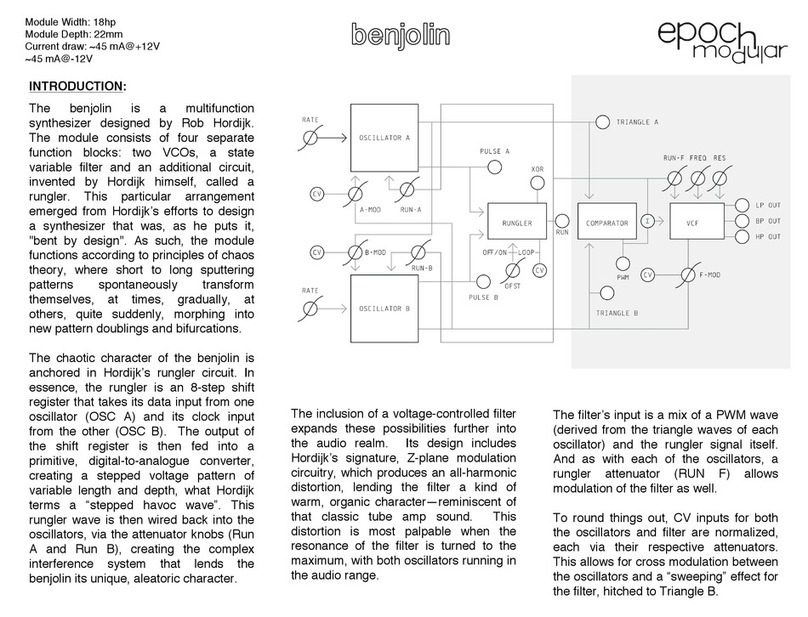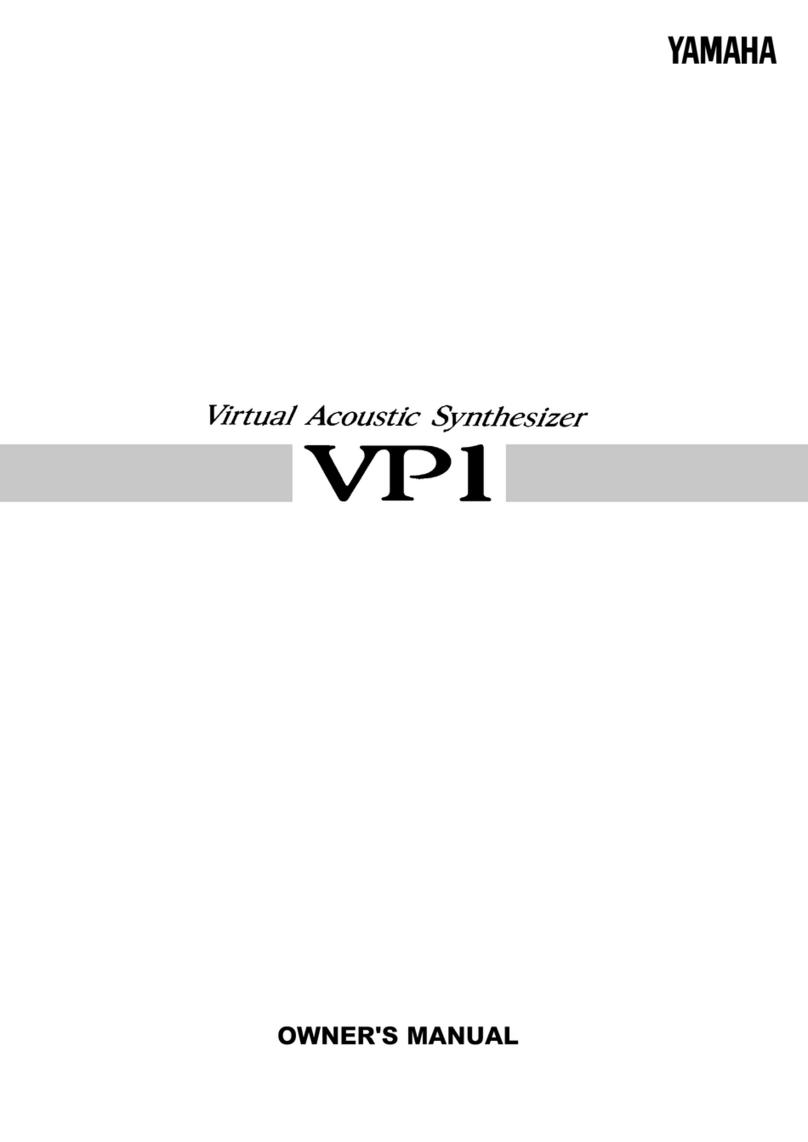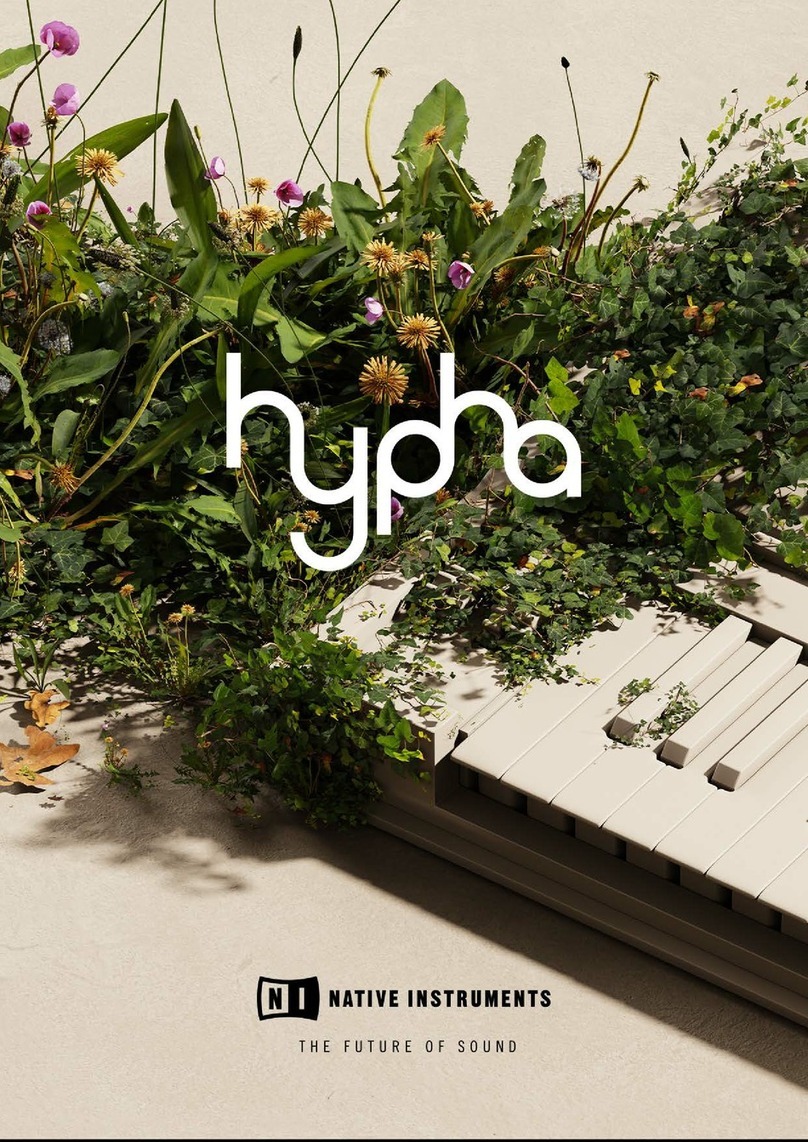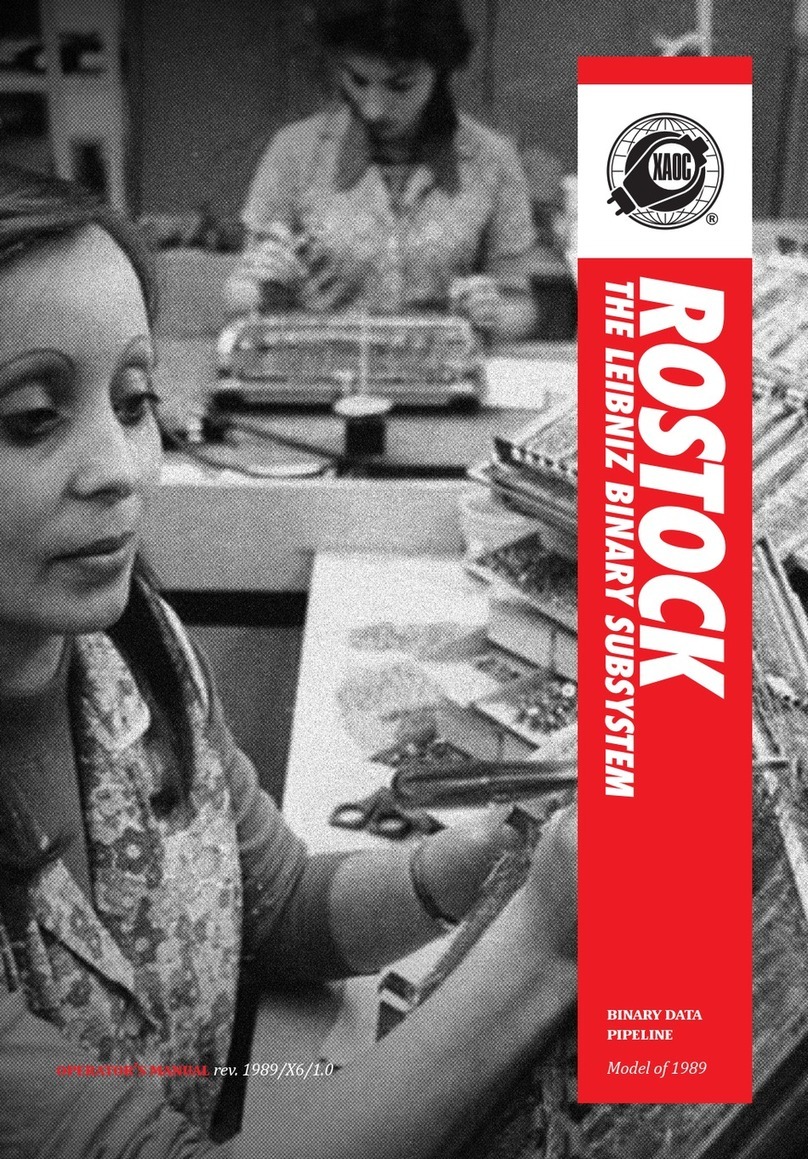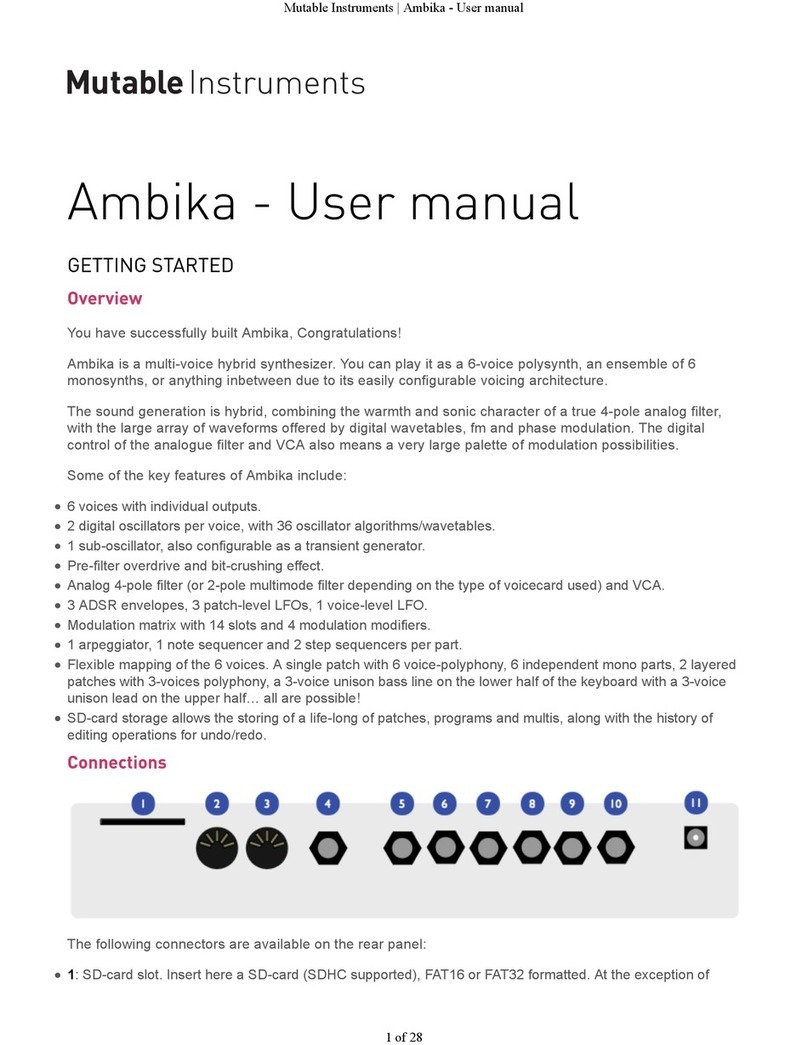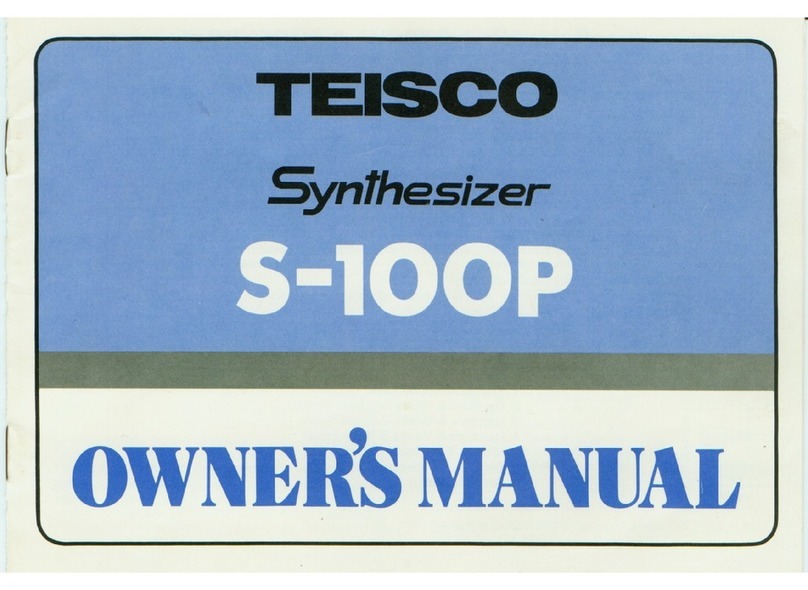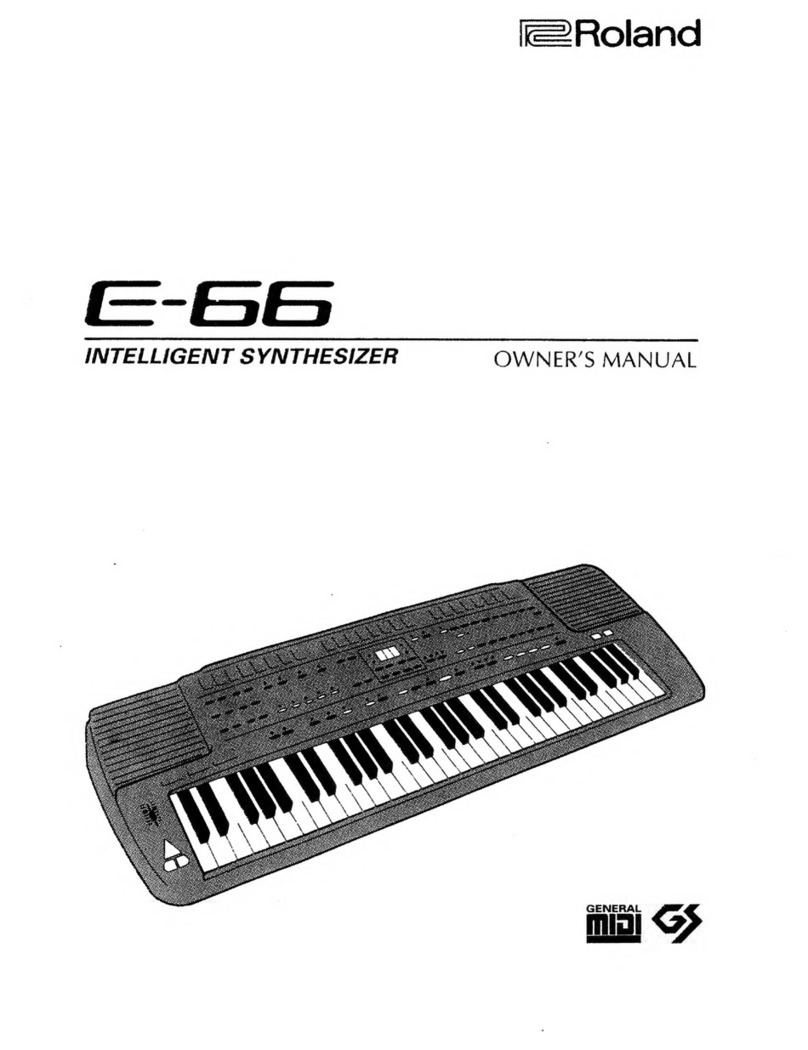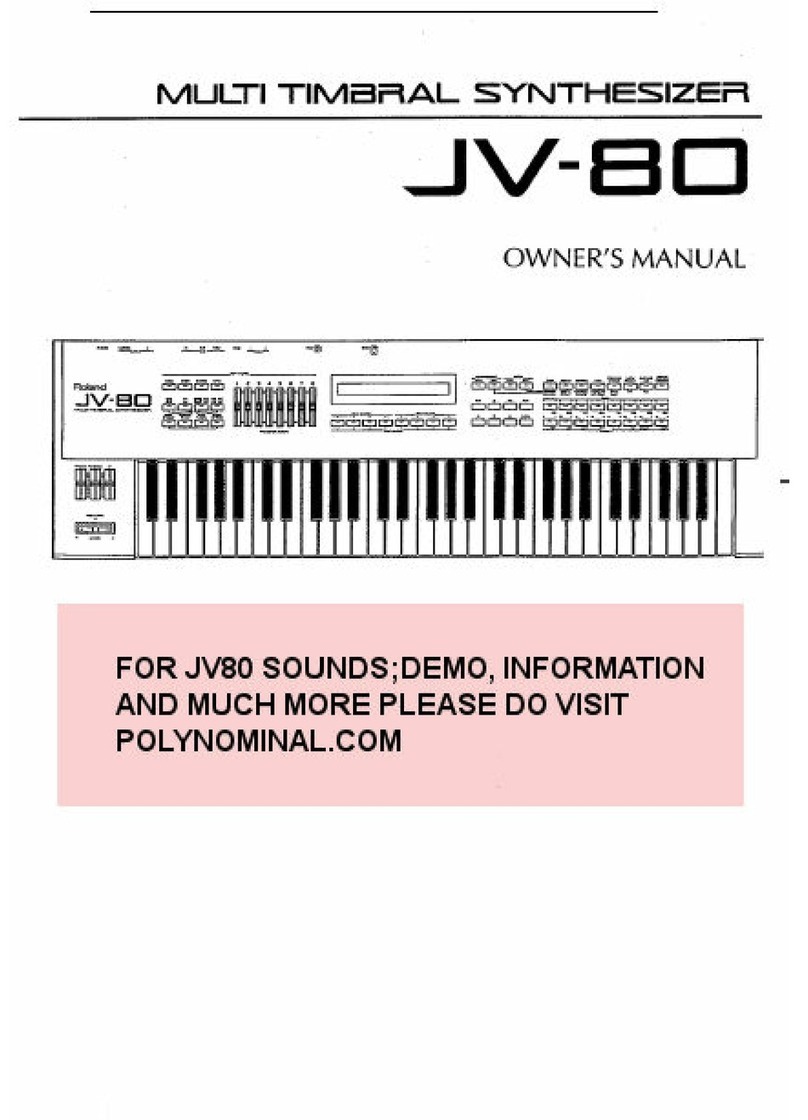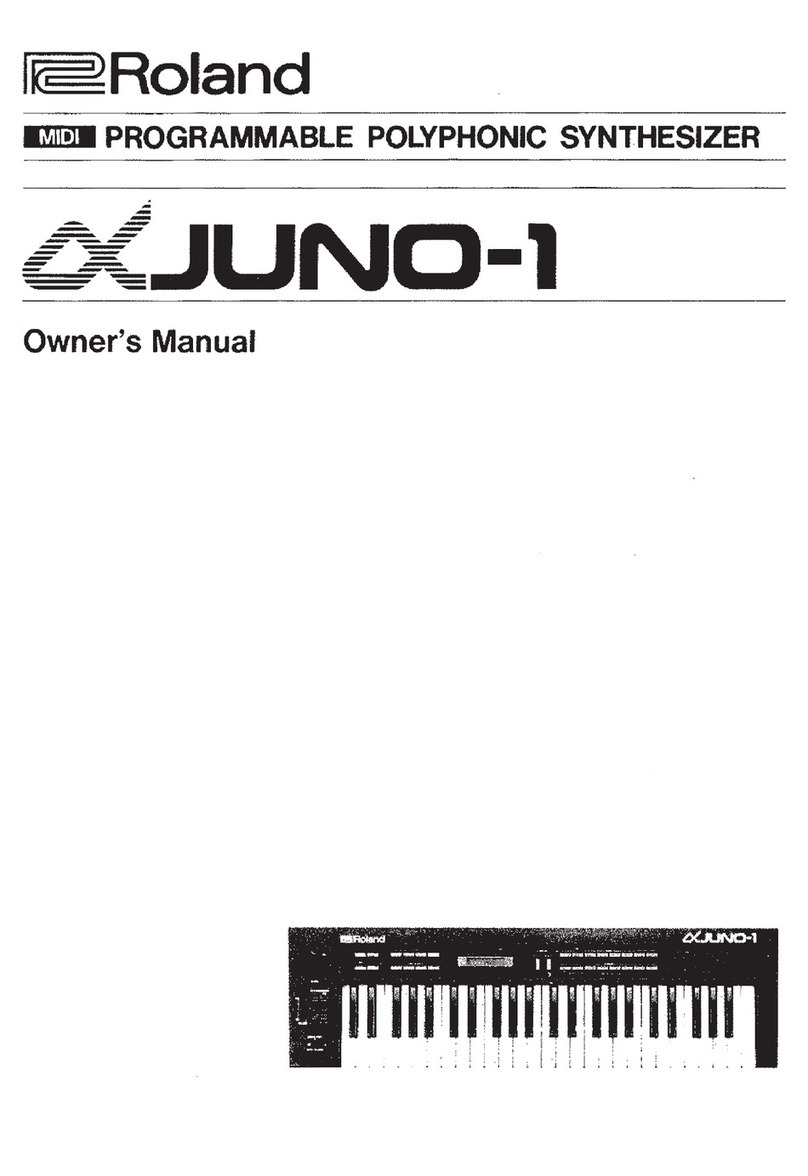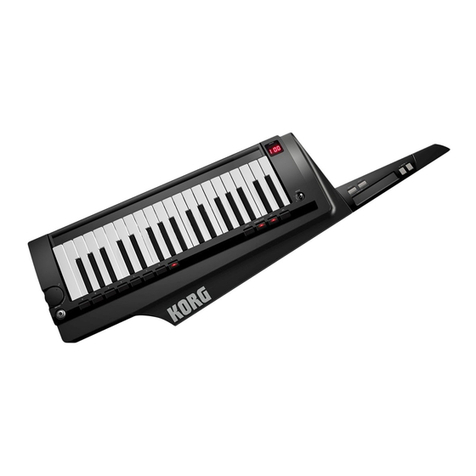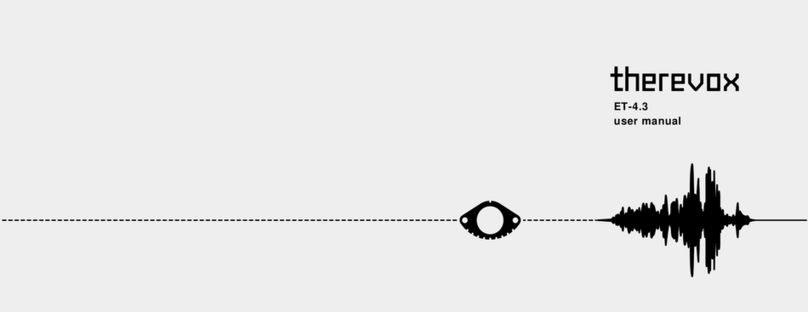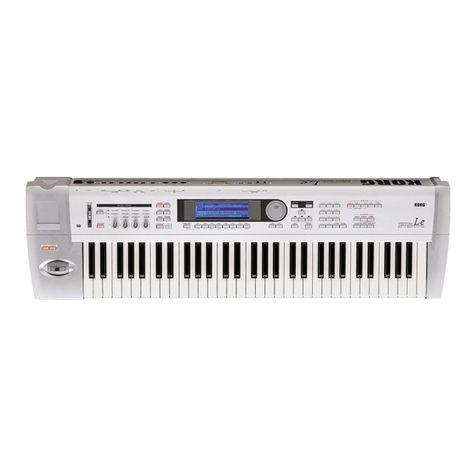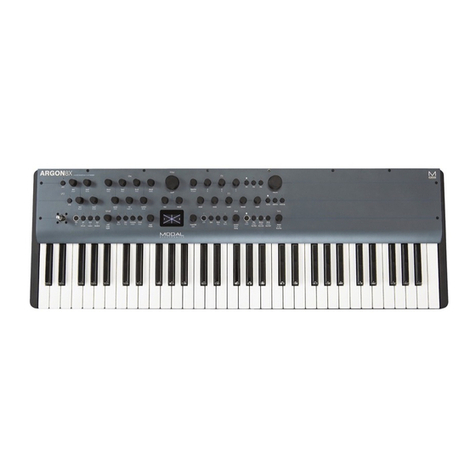memory moon ME80 User manual

ME80
Aftertouch Synthesizer
User guide
Version 2.4
ModulAir
Polyphonic Modular Synthesizer
Version 1.0
© 2018-2019 by Björn Arlt @ Full Bucket Music
http://www.fullbucket.de/music
VST is a trademark of Steinberg Media Technologies GmbH
Windows is a registered trademark of Microsoft Corporation
The Audio Units logo is a trademark of Apple Computer, Inc.
http://www.memorymoon.com

ME80 v2 - User Guide
2
Index
Chapter 1 - General 4!
1.1 - About ME80 4!
1.2 - Credits 4!
1.3 - Install 4!
Chapter 2 - Presets 5!
2.1 - Preset manager 5!
2.2 - Group preset 5!
2.3 - Preset selectors 6!
Chapter 3 - Controls 7!
3.1 - Performance settings 7!
3.2 - Morph and Random parameters control 7!
3.3 - Mod wheel parameters 8!
3.4 - Velocity and aftertouch parameters 9!
3.5 - Other aftertouch parameters 9!
3.6 - Keyboard control 10!
3.7 - Advanced parameters 10!
3.8 - Pedal controls parameters 11!
3.9 - Pitch ribbon 11!
3.10 - Using mouse to control aftertouch and bend 12!
3.11 - Drift Parameters 12!
3.12 - Midi Learn 14!
3.12 - Default Midi CC 14!
Chapter 4 - Synthesis 15!
4.1 - Oscillators 15!
4.2 - Sub-Oscillator 15!
4.3 - Synthlines mix and feet 16!
4.4 - Filter 16!
4.5 - VCA 17!
4.6 - Graphic envelope 17!
Chapter 5 - Effects units 18!

ME80 v2 - User Guide
3
5.1 - Delay 18!
5.2 - Tremolo/Chorus 18!
5.3 - Reverb 19!
5.4 - EQ 19!
5.5 - Distortion 20!
Chapter 6 - Other 21!
6.1 - Hint about fine adjustments with all sliders on the ME80 21!
6.2 - Troubleshooting 21!

ME80 v2 - User Guide
4
Chapter 1 - General
1.1 - About ME80
The ME80 is a classic analog synthesizer. In addition to the features on a Yamaha
CS80 the ME80 will give you:
• Patch memory for 128 patches.
• Group presets for each synthline and equalizer.
• You can select high-pass/low-pass for each filer.
• You can change the sine wave into a triangle with adjustable harmonics.
• You can change the Square wave into saw.
• Selectable mono, 8, 12, 16 and 24 voice polyphony, and selectable 0-8 voices
unison with detune knob.
• Drift page with sliders for random tuning of each voicecards every time you hit
a note and LFO for slow drift movements.
• Delay.
• Chorus/Tremolo.
• Reverb unit.
• EQ page with 2 graphic equalizers and distortion section between the
equalizers.
• Windows (VST 32/64bit) and MacOS X (Audio-Unit et VST 64bit) support
1.2 - Credits
• Design: Gunnare Ekornäs.
• Programming: Chris Kerry.
• Thanks to: Max Fazio et Georges Poropat.
• Presets: RG by Robin Grinall and PR by Paul Roach. 2 x 11 presets of presets
selectors by Max Fazio.
• English user manual rebuild: Laurent Bergman.
• VST is a trademark of Steinberg Media Technologies GmbH. Windows is a
registered trademark of Microsoft Corporation. MacOSX and Audio Unit Logo
is a registered trademark of Apple Computer Inc.
1.3 - Install
Uninstall old version.
Run .exe or .pkg file for your system.
PC users: Please browse to your VST plugins folder while running the installer. There
is a big chance that the default folder is wrong.

ME80 v2 - User Guide
5
Chapter 2 - Presets
2.1 - Preset manager
• Bank button: You can load installed bank. On Memorymoon webpage, you will
find an installer that will install 3 extra banks. Work on Mac too.
• Preset Name: Preset name. You can right-click on text to rename it.
• File button:
• Load preset.
• Save preset.
• Copy current preset.
• Paste to this preset.
• Load Bank.
• Save Bank.
• Load Midi CC Map.
• Save Midi CC Map.
• +/- arrows: To Prev/Next preset.
2.2 - Group preset
CC28 post EQ mid band gain (can be unlearned).
CC64 Normal Sustain pedal , or longer release when the "Sustain foot switch" is
activated, and portamento off/on when the "Portamento foot switch" is activated.
CC69 (avoid this , used for sustain pedals in many controllers)
CC120(avoid this - all sounds off)
You will find group presets save and load for synthline1, synthline2, performance
section and equalizer. "L" means load. "S" means save.
We have set the output level quite low in all patches to give headroom for increased
level by aftertouch.
Hint about fine adjustments with all sliders on the ME80:
You can press Ctrl to do fine adjustments, and Ctrl+Shift to do even finer
adjustments.
We did an accident and called the PC file ME80_2.3.dll in version 2.3. Then we found
out that we have to keep that file-name forever to privide compability with older
versions. So the 2.4 version has filename ME80_2.3.dll .
Some windows users experience that the ME80 will not show up on windows10
machines. New Win10 systems don't have all the historical runtime dlls installed.
Then you will have to put msvcp100.dll and msvcr100.dll manually in the
C:/windows/system folder. The files are available from Microsoft.
Please send me patches if you have created some. I am always interested.
Have fun!
You will find group presets save and load for synthline1, synthline2, performance
section and equalizer. "L" means load and "S" means save.

ME80 v2 - User Guide
6
2.3 - Preset selectors
There are 2 rows. One for synthline1 and one for synthline2. The presets are stored
independently for each patch.
How to copy from one preset location to another: Select the button to where you want
to store the preset. Then use the "copy from" function and select the preset you want
to copy.
It is even possible to overwrite all the factory Yamaha presets, but I suggest that you
keep them. Panel 1+2 (far right) is the default setting when you edit sounds. If you
edit sounds with the Yamaha preset selectors in Panel position you will keep all the
Yamaha synthline presets.

ME80 v2 - User Guide
7
Chapter 3 - Controls
3.1 - Performance settings
• Pitch: Tuning of the instrument. The little button below is auto-tune.
• CH 2 detune: Detuning of synthline2.
Ring modulator is the synth signal multiplied with a built-in sine-wave :
• Attack: Attack for the sine`s pitch envelope.
• Decay: Decay for the sine`s pitch envelope.
• Depth: Envelope depth. The envelope will be clipped when set to max
depth.
• Speed: Pitch for the sine wave (When you select Wheel destination in the
Sub-Oscillator section to "Ring" then the wheel will affect this slider).
• Mod: Level of the sine wave and this is the same as ring-mod level.
3.2 - Morph and Random parameters control
• Morph speed for synthline parameters. Works when you change patch, or
change the coloured preset buttons. Does not work with the performance
sliders, only synthline1 and synthline2 sliders/buttons.
• Rnd 1 - Rnd 2: Random switches for random parameters values for Synthlines
1 et 2.

ME80 v2 - User Guide
8
3.3 - Mod wheel parameters
Below the "wheel" slider you can select wheel destination:
PERFORMANCE SETTINGS
Pitch: Tuning of the instrument. The little button below is auto-tune.
CH 2 detune: Detuning of synthline2
Ring modulator is the synthsignal multiplied with a built-in sine-wave.
Attack: Attack for the sine`s pitch envelope.
Decay: Decay for the sine`s pitch envelope.
Depth: Envelope depth. The envelope will be clipped when set to max depth.
Speed: Pitch for the sine wave.(When you select Wheel destination in the sub osc
section to "Ring" then the wheel will affect this slider).
Mod: Level of the sine wave and this is the same as ring-mod level.
The sub-oscillator is the instrument`s LFO.
Wave: Select from 6 waveforms. The noise waveform is brown-noise.
Speed: The rate of the LFO.
Sync: Sync to host clock. Note values becomes visible when on.
VCO: LFO sent to all oscillators pitch. (Vibrato)
VCF: LFO sent to all filters.
VCA: LFO sent to VCA to control level in both synthlines.
Wheel: The amount of LFO sent to the destination in the text box below the slider.
There is a button next to the "wheel" text. When it is off the wheel sets amount of
• VCO: Oscillators pitch.
• Mix: Will add voltage so you can morph from synthline1 to synthline2
with mod wheel.
• Ring: Control of Speed fader of Ring Modulator.
• Pan: Pan.
• Eq 2 Freq: EQ 2 band2 freq.
• Eq 2 Gain: EQ2 band2 gain.
• VCF: VCF cutoff.
The amount of LFO sent to the destination. There is a button next to the "wheel" text.
When it is off the wheel sets amount of LFO level. When it is on the wheel will send
its current value, no LFO is involved.

ME80 v2 - User Guide
9
3.4 - Velocity and aftertouch parameters
Decay: Time to reach zero.
Release: Time to reach IL. The envelope starts and ends with IL. Switch to ENV
page to see the graphic envelope.
VCA
VCF level: Level of the filter into the VCA section.
Sine level: Level of the sine. It is inserted after the filter, and is not affected by the
filter. It is used to recreate the fundamental when HPF has removed it from the other
oscillators. You can click the sine symbol and turn it into a triangle wave, and it is
possible to set its harmonics on the drift page.
Level: Output level from the VCA.
VELOCITY AND AFTERTOUCH
Initial brilliance: Velocity sent to filter cutoff.
Initial level: Velocity sent to VCA to modify level.
After brilliance: Aftertouch sent to filter cutoff.
After level: Aftertouch send to VCA to modify level.
This are the most important parameters for the special CS-experience. ME80 should
be played with a good aftertouch keyboard. Polyphonic aftertouch is supported.
• Initial brilliance: Velocity sent to filter cutoff.
• Initial Level: Velocity sent to VCA to modify level.
• After brilliance: Aftertouch sent to filter cutoff.
• After Level: Aftertouch send to VCA to modify level.
This are the most important parameters for the special CS-experience. ME80 should
be played with a good aftertouch keyboard. Polyphonic aftertouch is supported.
3.5 - Other aftertouch parameters
• Bend: Initial pitch bend envelope controlled by velocity.
• Speed: Aftertouch will increase the rate of the LFO.
• VCO: Aftertouch will increase the LFO level to oscillator pitch (Vibrato).
• VCF: Aftertouch will increase the LFO level sent to filter cutoff.
You can click on "ALL" and select "LAST PLAYED". This is a kind of fake polyphonic
aftertouch. When set to "last played" aftertouch will only affect last played note.
(Notes if several notes are played at the same time).

ME80 v2 - User Guide
10
3.6 - Keyboard control
This section makes it possible to alter the instruments response for the upper and
lower keys on the keyboard. Middle slider position is default. The curve is exp as you
move from the middle part of the keyboard. It is often used to increase the level of
the lower keys, since they may feel weak because of the instruments built-in
agressive keyboard filter scaling. For more information: Read the YAMAHA CS80
manuals.
Almost invincible small button to the left: When "off" keyboard filter tracking is on like
it always is on the Yamaha CS80. When "on" the keyboard tracking is switched off.
We chose that order to make it compatible with older patches
Brilliance low: Filter cutoff for the lowest keys.
Brilliance high: Filter cutoff for the highest keys.
Low level: Level for the lowest keys.
High level: Level for the highest keys.
Middle position is zero.
DELAY
Sync: Sync to host clock.
Right 2X: Double delay times for right output.
Feedback: Number of repetitions.
The unlabelled knob is a "quality" knob. It reduces the bandwidth like a Bucket
Brigade Delay. 100% Quality = 100% Digital as in previous versions. Lower Quality
reduces bandwidth.
Unlabelled big button to the right: Global master off/on for delay.
This section makes it possible to alter the instruments response for the upper and
lower keys on the keyboard. Middle slider position is default. The curve is exp as you
move from the middle part of the keyboard. Middle position is zero. It is often used to
increase the level of the lower keys, since they may feel weak because of the
instruments built-in agressive keyboard filter scaling. For more information: Read
the YAMAHA CS80 manuals.
• VCF Tracking: Almost invisible small button to the left : When "off" keyboard
filter tracking is on like it always is on the Yamaha CS80. When "on" the
keyboard tracking is switched off. We chose that order to make it compatible
with older patches.
• Brillance Low: Filter cutoff for the lowest keys.
• Brillance High: Filter cutoff for the highest keys.
• Level Low: Level for the lowest keys.
• Level High: Level for the highest keys.
3.7 - Advanced parameters
Preset selectors:
There are 2 rows. One for synthline1 and one for synthline2. The presets are stored
independently for each patch.
How to copy from one preset location to another: Select the button to where you want
to store the preset. Then use the "copy from" function and select the preset you want
to copy.
It is even possible to overwrite all the factory Yamaha presets, but I suggest that you
keep them. Panel 1+2 (far right) is the default setting when you edit sounds. If you
edit sounds with the Yamaha preset selectors in Panel position you will keep all the
Yamaha synthline presets.
PAGE
DRIFT: Drift page for oscillator drift.
KBD: Animated GUI keyboard.
ENV: GUI envelopes.
EQ: Equalizer and distortion.
Reverb:
Unlabelled big button: Global master off/on for reverb.
Damp: Makes the reverb sound darker.
• DRIFT: Show Drift parameters.
• KBD: Show keyboard (default).
• ENV1: Show ENV1 graphics.
• ENV2: Show ENV1 graphics.
• EQ: Show EQ’s and distorsion unit.

ME80 v2 - User Guide
11
3.8 - Pedal controls parameters
Foot selector means operation mode for the expression pedal (CC11):
Wah: Cutoff for a wah filter at the end of the sound-chain. (Will increase the signal`s
resonance when on). Exp: Level. Exp Wah: Expression pedal controls both wah
filter cutoff and level. The knob above "wah" is a monitor for the expression pedal. It
will move when you move the pedal. It is set to CC11 Expression pedal by default,
but you can right-click it and do midi-learn, or set another CC number.
In some patches you will hear a pan effect. That is the Chorus/tremolo section.
Yamaha CS80 used a 3rd party Chorus/tremolo unit produced by Panasonic.
According to Max Fazio it is there mostly to simulate Rotary Speaker effect, or Leslie.
Chorus and Tremolo is the same effect, the only difference is the speed. Chorus is
slow, and Tremolo is fast. Panning is a part of the effect. So if you want slow Leslie
from "the factory organ" patch, just switch off tremolo, so that only chorus remains
activated.
Sustain: Master control for both synthline`s release times.
Porta: Portamento time.
Porta/Gliss selector: Porta is normal portamento. When set to Gliss the portamento
will quantisize to nearest semitone.
Foot switch: Controlled by CC64 sustain pedal. (This is the standard CC number for
sustain pedal).
Sustain: Release only when foot switch (CC64) is down.
Port: Portamento only when foot switch (CC64) is down.
SUSTAIN MODE 1 AND 2.
Mode1: Normal mode like other synths. Mode2: Only release for last played notes.
This will feel like a mono-mode and makes fast playing possible even with long
release times.
Chorus/Tremolo: (Sounds more like a leslie-speaker than a chorus).
On: Master on/off switch for the chorus circuit. The volume will feel lower because of
phase cancellation.
• Destination:
• Wah: Cutoff for a wah filter at the end of the sound-chain. (Will increase
the signal`s resonance when on).
• Exp: Level. Exp.
• Exp Wah: Expression pedal controls both wah filter cutoff and level.
• Wah: The knob above "wah" is a monitor for the expression pedal. It will move
when you move the pedal. It is set to CC11 Expression pedal by default, but you
can right-click it and do midi-learn, or set another CC number.
• Foot Switch: Controlled by CC64 sustain pedal. (This is the standard CC
number for sustain pedal).
• Sustain: Release only when foot switch (CC64) is down.
• Port: Portamento only when foot switch (CC64) is down.
• Sustain Mode 1: Normal mode like other synths.
• Sustain Mode 2: Only release for last played notes. This will feel like a mono-
mode and makes fast playing possible even with long release times.
• Porta/Gliss: Porta is normal portamento. When set to Gliss the portamento
will quantisize to nearest semitone.
3.9 - Pitch ribbon
You can use the mouse or the bender to control the pitch ribbon.
• The unlabelled knob sets the range of the ribbon. At lowest setting: 2
semitones up and 2 semitones down. At highest setting: One octave up, and
almost down to zero Hz.
Polyphony selector:
• Voices: Mono, 8 voices, 12 voices, 16 voices and 24 voices. The original had 8
voices, so the purists can set it to 8 voices. Older patches will load with 12
voices like the 2.3 version.
• Unison: Number of unison voices. From "off" to 8 voices.
• Detune: Detuning of each voice in unison mode. It is not linear.
• Spread: Pan spread. Each voice is spread with its own unique place in the
stereo field from right to left.

ME80 v2 - User Guide
12
3.10 - Using mouse to control aftertouch and bend
• KBD Bend: A setting for the GUI keyboard.
• After: Horizontal mouse movement is scrolling.
• Wheel: Horizontal mouse movement is bend, vertical mouse movement is
mod-wheel.
3.11 - Drift Parameters
Go to "DRIFT" page:
GUI ENVELOPES
Left click to change envelope curve for each stage.
This is how the GUI Equalizer works:
Press RIGHT-CLICK and drag - this alters WIDTH/Q(Left/Right) and GAIN(Up/Down)
Press LEFT-CLICK and Drag - this alters FREQ(Left/Right) and GAIN(Up/Down)
If you Double Click on an EQ Band it will reset the Gain to Zero
DRIFT PAGE
The blue curve image to the left is velocity curve. Click on the image to change
curve.
There are 2 independent pitch LFOs:
Line1: Drift LFO for synthline1 with level and speed slider.
Line2: Drift LFO for synthline2 with level and speed slider.
PITCH RANDOM: Pitch drift with random values for every single note with
independent sliders for synthline 1 and 2. This is to emulate the differences between
the voicecards.
PW RANDOM: Pulse-width drift with random values for all 8 voicecards.
In version 1 you could offset pitch, filter and PW for each voicecard with a slider. In
version 2 we changed that and instead set a random value for pitch, filter and PW at
each note (at each individual voicecard) to make it even more random. So in the drift
page you first have 2 LFOs for doing slow pitch changes up and down for all
voicecards. After that you have sliders to set individual random values for each
voicecard each time you play a new note. The Yamaha CS80 is known to have very
big differences between each voicecard. So was the CS80 we modelled the ME80
after. Especially the randomness of the PW values was crazy.
The blue curve image to the left is velocity curve. Click on the image to change curve.
There are 2 independent pitch LFOs.
• Line1:
• Drift: Drift LFO for synthline1 with level and speed slider.
• Line2 :
• Drift: Drift LFO for synthline2 with level and speed slider.
• Pitch Random: Pitch drift with random values for every single note with
independent sliders for synthline 1 and 2. This is to emulate the differences
between the voicecards.
• PW Random: Pulse-width drift with random values for all 8 voicecards.

ME80 v2 - User Guide
13
In version 1 you could offset pitch, filter and PW for each voicecard with a slider. In
version 2 we changed that and instead set a random value for pitch, filter and PW at
each note (at each individual voicecard) to make it even more random. So in the drift
page you first have 2 LFOs for doing slow pitch changes up and down for all
voicecards. After that you have sliders to set individual random values for each
voicecard each time you play a new note. The Yamaha CS80 is known to have very big
differences between each voicecard. So was the CS80 we modelled the ME80 after.
Especially the randomness of the PW values was crazy.
The blue curve image to the right is aftertouch curve. V1.0 had inv-exp aftertouch
curve.
Square detune: Detuning of the square in both synthlines. By default the saw and
square has the same phase per synthline. When you detune the square the waves
will not be synced anymore.
Dual saw: Adds an extra saw in both synthlines.
Dual saw detune: Detuning of the extra saw.
OBS: Middle position is zero for the detuning sliders! You can have negative or
positive detuning.
Sine harmonics: Will only have effect when the sine is replaced by a triangle wave ,
since the sine has only one harmonic. You can control the number of harmonics in
the triangle wave in both synthlines with this slider.
After speed: Smoothing of aftertouch. The higher value - the more smoothing. It will
make the aftertouch signals slower and more even.
Bend speed: Smoothing of bender signals to the ribbon.
EQ PAGE
3 band EQ pre and 3 band EQ post. At the bottom there are off/on switches for eq
and overdrive. When overdrive is "off" you can use the both EQs as a big 6 band
Equalizer. Volume compensated overdrive. You can adjust EQ with GUI or old-style
knobs. Midi-learn (and unlearn) for all bands. It is a Fully Parametric EQ; Frequency,
Gain and Width(Q) controls - All can be automated or set to MidiCC/NRPN. Midi-
learn implemented in the old-style knobs.
The blue curve image to the right is aftertouch curve. V1.0 had inv-exp aftertouch
curve.
• Square Detune: Detuning of the square in both synthlines. By default, the saw
and square has the same phase per synthline. When you detune the square the
waves will not be synced anymore.
• Dual saw detune: Detuning of the extra saw.
Note: Middle position is zero for the detuning sliders! You can have negative or
positive detuning.
• Sine harmonics: Will only have effect when the sine is replaced by a triangle
wave , since the sine has only one harmonic. You can control the number of
harmonics in the triangle wave in both synthlines with this slider.
• After Speed: Smoothing of aftertouch. The higher value - the more smoothing.
It will make the aftertouch signals slower and more even.
• Bend Speed: Smoothing of bender signals to the ribbon.

ME80 v2 - User Guide
14
3.12 - Midi Learn
Drive: This sets the distortion Sound. It sets the amount of signal Gain or boost
before it enters the distortion and equates to 'Amount of distortion'.
Squash: This alters the distortion Tone. It determines the shape of the distortion
above the threshold. Or - 'How much the signal is squashed down above the
distortion threshold' With low values the distortion has rounded 'edges' which give a
softer tone At 100% the distortion is hard-clipped - square 'edges' which give a
harsher tone The Squash effect is quite subtle especially with high Drive levels where
the signal is mostly being clipped. It is most applicable to Bass distortion sounds.
MIDI-LEARN
Stored in patches and banks. Just right click any slider, and you can do midi-learn or
set a CC number.
You can also save CC assignments as presets from the menu where you save and
load patches as a separate file.
"Portamento foot switch" function now controlled by CC64 (Sustain pedal). It was
CC65 in the 1.0 version. When "portamento foot switch" is on - then the normal
sustain pedal hold function is disabled.
Current pre-set CC numbers:
CC1 Mod wheel
CC2 Breath control (routed to the aftertouch system inside the synth).
CC7 Master volume
CC11 Expression pedal - there is a selector in ME80 to select exp, wah or exp+wah.
The wah-knob is simply a monitor for the expression pedal, it will move when you
move the exp pedal. You can right-click to set it to another value than CC11 or
unlearn it. It is very useful for instance if you have no sound, then you can look at the
wah/exp-knob and see its position.
CC25 pre EQ mid band freq (can be unlearned).EQ band CC's are pre-set for the
Novation Launchpad mini knobs 5,6,7,8.
CC26 pre EQ mid band gain (can be unlearned).
CC27 post EQ mid band freq (can be unlearned).
Stored in patches and banks. Just right click any slider, and you can do midi-learn or
set a CC number.
You can also save CC assignments as presets from the menu where you save and load
patches as a separate file.
"Portamento foot switch" function now controlled by CC64 (Sustain pedal). It was
CC65 in the 1.0 version. When "portamento foot switch" is on - then the normal
sustain pedal hold function is disabled.
3.12 - Default Midi CC
CC1: Mod wheel.
CC2: Breath control (routed to the aftertouch system inside the synth).
CC7: Master volume.
CC11: Expression pedal - there is a selector in ME80 to select exp, wah or exp+wah.
CC25: Pre EQ mid band freq (can be unlearned). EQ band CC's are pre-set for the
Novation Launchpad mini knobs 5,6,7,8.
CC26: Pre EQ mid band gain (can be unlearned).
CC27: Post EQ mid band freq (can be unlearned).
CC28: Post EQ mid band gain (can be unlearned).
CC64: Normal Sustain pedal, or longer release when the "Sustain foot switch" is
activated, and portamento off/on when the "Portamento foot switch" is activated.
CC69: (avoid this, used for sustain pedals in many controllers).
CC120: (avoid this - all sounds off).

ME80 v2 - User Guide
15
Chapter 4 - Synthesis
4.1 - Oscillators
• Speed: PWM modulation speed from 0.5 to 50 Hz for the square wave.
• PWM: Pulse width modulation level.
• PW: Pulse width. From 50 to 90 %.
When both waves are switched on the ME80 will be muted for a second, and both
oscillators set to same phase, unless the square is detuned on the drift page. You can
click on the square symbol and turn it into a saw wave.
Double saw wave from the saw is available by clicking a button on the drift page.
There you will also find dual-saw detuning. You can have 3 saws form each synthline
by switching the square to a saw wave, and enable double saw from the drift page.
With 2 synthlines there will be 6 saw oscillators.
• Noise: Noise generator level.
4.2 - Sub-Oscillator
The sub-oscillator is the instrument's LFO.
• Wave: Select from 6 waveforms. The noise waveform is brown-noise.
• Speed: The rate of the LFO.
• VCO: LFO sent to all oscillators pitch. (Vibrato).
• VCF: LFO sent to all filters.
• VCA: LFO sent to VCA to control level in both synthlines.
• Sync: Sync to host clock. Note values becomes visible when on.
• Wheel: The amount of LFO sent to the destination in the text box below the
slider.
As described (chapter 3.3), the amount of LFO sent to the destination. There is a
button next to the "wheel" text. When it is off the wheel sets amount of LFO level.
When it is on the wheel will send its current value, no LFO is involved.

ME80 v2 - User Guide
16
4.3 - Synthlines mix and feet
LFO level. When it is on the wheel will send its current value, no LFO is involved.
Below the wheel slider you can select wheel destinations: VCO pitch, Synthline mix
(Will add voltage so you can morph from synthline1 to synthline2 with mod wheel),
ring-mod speed, pan, EQ2 band2 freq, EQ2 band2 gain, and VCF cutoff.
Feet: Octave settings for the oscillator pitch. Tuned in fifths and octaves.
Mix: Level balance for synthline1 and synthline2.
Brill: Master cutoff for both synthlines.
Res: Master resonance for both synthlines.
Touch response=aftertouch settings.
Bend: Initial pitch bend envelope controlled by velocity.
Speed: Aftertouch will increase the rate of the LFO.
VCO: Aftertouch will increase the LFO level to oscillator pitch. (Vibrato).
VCF: Aftertouch will increase the LFO level sent to filter cutoff.
You can click on "ALL" and select "LAST PLAYED". This is a kind of fake polyphonic
aftertouch. When set to "last played" aftertouch will only affect last played note.
(Notes if several notes are played at the same time.)
• Feet: Octave settings for the oscillator pitch. Tuned in fifths and octaves.
• Mix: Level balance for synthline1 and synthline2.
• Brill: Master cutoff for both synthlines.
• Res: Master resonance for both synthlines.
4.4 - Filter
ME 80 has 2 filters for each synthline. A high-pass and low-pass filter together will
sound like a band-pass filter. The filters are 12Db/octave.
You can click on HPF and LPF labels to change their mode. The GX1 had the option
to change the filter order, first a LPF, then a HPF. You can achieve this by clicking on
the HPF and LFP labels.
• HPF: High-pass filter cutoff.
• Res: High-pass filter resonance (No self-oscillation).
• LPF: Low-pass filter cutoff.
• Res: Low-pass filter resonance (No self-oscillation).

ME80 v2 - User Guide
17
Filter envelope
Sustain level is zero and matches with cutoff level.
• IL: Initial Level when the envelope starts. 0 to -5 volts (negative values).
• AL: Attack Level at the highest point. 0 to 5 volts (positive values).
• Attack: Time to reach the highest point set by the Attack Level.
• Decay: Time to reach zero.
• Release: Time to reach IL. The envelope starts and ends with IL.
Switch to "ENV" page to see the graphic envelope.
4.5 - VCA
• VCF Level: Level of the filter into the VCA section.
• Sine Level: Level of the sine. It is inserted after the filter, and is not affected by
the filter. It is used to recreate the fundamental when HPF has removed it
from the other oscillators. You can click the sine symbol and turn it into a
triangle wave, and it is possible to set its harmonics on the drift page.
• Level: Output level from the VCA.
4.6 - Graphic envelope
Go to "ENV1" page for Synthline1 or "ENV2" for Synthline2:
Left click to change envelope curve for each stage.

ME80 v2 - User Guide
18
Chapter 5 - Effects units
5.1 - Delay
This section makes it possible to alter the instruments response for the upper and
lower keys on the keyboard. Middle slider position is default. The curve is exp as you
move from the middle part of the keyboard. It is often used to increase the level of
the lower keys, since they may feel weak because of the instruments built-in
agressive keyboard filter scaling. For more information: Read the YAMAHA CS80
manuals.
Almost invincible small button to the left: When "off" keyboard filter tracking is on like
it always is on the Yamaha CS80. When "on" the keyboard tracking is switched off.
We chose that order to make it compatible with older patches
Brilliance low: Filter cutoff for the lowest keys.
Brilliance high: Filter cutoff for the highest keys.
Low level: Level for the lowest keys.
High level: Level for the highest keys.
Middle position is zero.
DELAY
Sync: Sync to host clock.
Right 2X: Double delay times for right output.
Feedback: Number of repetitions.
The unlabelled knob is a "quality" knob. It reduces the bandwidth like a Bucket
Brigade Delay. 100% Quality = 100% Digital as in previous versions. Lower Quality
reduces bandwidth.
Unlabelled big button to the right: Global master off/on for delay.
• Quality: The unlabelled knob is a "quality" knob. It reduces the bandwidth like
a Bucket Brigade Delay. 100% Quality = 100% Digital as in previous versions.
Lower Quality reduces bandwidth.
• Sync: Sync to host clock.Right 2X: Double delay times for right output.
Feedback: Number of repetitions.
• Right x2: Double delay times for right output.
• Feedback: Number of repetitions.
• On/Off: Unlabelled big button to the right, global master off/on for delay.
5.2 - Tremolo/Chorus
In some patches you will hear a pan effect. That is the Chorus/tremolo section.
Yamaha CS80 used a 3rd party Chorus/tremolo unit produced by Panasonic.
According to Max Fazio it is there mostly to simulate Rotary Speaker effect, or Leslie.
Chorus and Tremolo is the same effect, the only difference is the speed. Chorus is
slow and Tremolo is fast. Panning is a part of the effect. So if you want slow Leslie
from "the factory organ" patch, just switch off tremolo, so that only chorus remains
activated.
• Tremolo: High speed for tremolo effect. Use this button to select high and low
speed. The unit will morph between low and high speed like a Leslie.
• Chorus: Low speed for chorus.
• On/Off: Master on/off switch for the chorus circuit. The volume will feel lower
because of phase cancellation.
• Quality: New "quality" knob in the chorus section. Reduces bandwidth like old
analogue equipment. 100% Quality = 100% Digital as in previous versions.

ME80 v2 - User Guide
19
5.3 - Reverb
• On/Off: Global master off/on for reverb.
• Damp: Makes the reverb sound darker.
5.4 - EQ
Go to "EQ" page:
The blue curve image to the right is aftertouch curve. V1.0 had inv-exp aftertouch
curve.
Square detune: Detuning of the square in both synthlines. By default the saw and
square has the same phase per synthline. When you detune the square the waves
will not be synced anymore.
Dual saw: Adds an extra saw in both synthlines.
Dual saw detune: Detuning of the extra saw.
OBS: Middle position is zero for the detuning sliders! You can have negative or
positive detuning.
Sine harmonics: Will only have effect when the sine is replaced by a triangle wave ,
since the sine has only one harmonic. You can control the number of harmonics in
the triangle wave in both synthlines with this slider.
After speed: Smoothing of aftertouch. The higher value - the more smoothing. It will
make the aftertouch signals slower and more even.
Bend speed: Smoothing of bender signals to the ribbon.
EQ PAGE
3 band EQ pre and 3 band EQ post. At the bottom there are off/on switches for eq
and overdrive. When overdrive is "off" you can use the both EQs as a big 6 band
Equalizer. Volume compensated overdrive. You can adjust EQ with GUI or old-style
knobs. Midi-learn (and unlearn) for all bands. It is a Fully Parametric EQ; Frequency,
Gain and Width(Q) controls - All can be automated or set to MidiCC/NRPN. Midi-
learn implemented in the old-style knobs.
3 band EQ pre and 3 band EQ post. At the bottom there are off/on switches for EQ
and overdrive. When overdrive is "off" you can use the both EQs as a big 6 band
Equalizer. Volume compensated overdrive. You can adjust EQ with GUI or old-style
knobs. Midi-learn (and unlearn) for all bands. It is a Fully Parametric EQ; Frequency,
Gain and Width(Q) controls - All can be automated or set to MidiCC/NRPN. Midi-
learn implemented in the old-style knobs.
The blue curve image to the right is aftertouch curve. V1.0 had inv-exp aftertouch
curve.
Square detune: Detuning of the square in both synthlines. By default the saw and
square has the same phase per synthline. When you detune the square the waves
will not be synced anymore.
Dual saw: Adds an extra saw in both synthlines.
Dual saw detune: Detuning of the extra saw.
OBS: Middle position is zero for the detuning sliders! You can have negative or
positive detuning.
Sine harmonics: Will only have effect when the sine is replaced by a triangle wave ,
since the sine has only one harmonic. You can control the number of harmonics in
the triangle wave in both synthlines with this slider.
After speed: Smoothing of aftertouch. The higher value - the more smoothing. It will
make the aftertouch signals slower and more even.
Bend speed: Smoothing of bender signals to the ribbon.
EQ PAGE
3 band EQ pre and 3 band EQ post. At the bottom there are off/on switches for eq
and overdrive. When overdrive is "off" you can use the both EQs as a big 6 band
Equalizer. Volume compensated overdrive. You can adjust EQ with GUI or old-style
knobs. Midi-learn (and unlearn) for all bands. It is a Fully Parametric EQ; Frequency,
Gain and Width(Q) controls - All can be automated or set to MidiCC/NRPN. Midi-
learn implemented in the old-style knobs.

ME80 v2 - User Guide
20
5.5 - Distortion
Go to "EQ" page:
The blue curve image to the right is aftertouch curve. V1.0 had inv-exp aftertouch
curve.
Square detune: Detuning of the square in both synthlines. By default the saw and
square has the same phase per synthline. When you detune the square the waves
will not be synced anymore.
Dual saw: Adds an extra saw in both synthlines.
Dual saw detune: Detuning of the extra saw.
OBS: Middle position is zero for the detuning sliders! You can have negative or
positive detuning.
Sine harmonics: Will only have effect when the sine is replaced by a triangle wave ,
since the sine has only one harmonic. You can control the number of harmonics in
the triangle wave in both synthlines with this slider.
After speed: Smoothing of aftertouch. The higher value - the more smoothing. It will
make the aftertouch signals slower and more even.
Bend speed: Smoothing of bender signals to the ribbon.
EQ PAGE
3 band EQ pre and 3 band EQ post. At the bottom there are off/on switches for eq
and overdrive. When overdrive is "off" you can use the both EQs as a big 6 band
Equalizer. Volume compensated overdrive. You can adjust EQ with GUI or old-style
knobs. Midi-learn (and unlearn) for all bands. It is a Fully Parametric EQ; Frequency,
Gain and Width(Q) controls - All can be automated or set to MidiCC/NRPN. Midi-
learn implemented in the old-style knobs.
• Drive : This sets the distortion Sound. It sets the amount of signal Gain or
boost before it enters the distortion and equates to "Amount of distortion".
• Squash : This alters the distortion Tone. It determines the shape of the
distortion above the threshold. Or - 'How much the signal is squashed down
above the distortion threshold' With low values the distortion has rounded
'edges' which give a softer tone. At 100% the distortion is hard-clipped - square
'edges' which give a harsher tone The Squash effect is quite subtle especially
with high Drive levels where the signal is mostly being clipped. It is most
applicable to Bass distortion sounds.
• L/S: Load/Save group preset.
Table of contents
